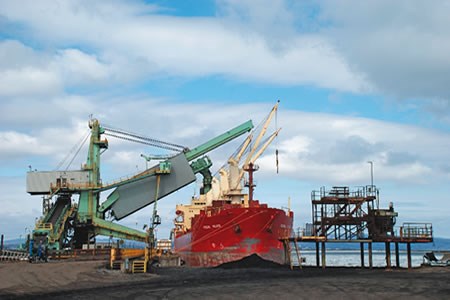A coal crunch by the major European steelmaker proved to be a blessing for the Port of Thunder Bay this past spring.
A combination of port delays in Vancouver and disruptions with suppliers prompted Corus, the world’s sixth-largest steel producer, to shift its British Columbia coal traffic east through Thunder Bay Terminals.
In April, the Federal Polaris was the first of seven saltwater vessels to take on metallurgical coal destined for steel mills in the United Kingdom. The vessel loaded 18,042 tonnes and departed in early April for Immingham, England. The last ship, the Irma, sailed June 27 with 22,429 tonnes aboard.
Overall, 150,000 tonnes of coal from Elk Valley Coal Company moved through the northwestern Ontario port this year.
It was the first time metallurgical coal, used in steelmaking blast furnaces, was exported through the northwestern Ontario port.
Lakehead Shipping Company general manager William Hryb, the vessel agent for Corus, says shipping through the St. Lawrence Seaway toll system is more costly than accessing West Coast ports, but it came down to a just-in-time issue.
In looking for an alternative route, Hryb says Corus approached Elk Valley Coal. The company is familiar with the coal-handing facilities at Thunder Bay Terminals on McKellar Island. Owned by Russel Metals, the terminal’s modern coal and potash loop belt system can quickly load ships at a rate of 7,000 tonnes an hour.
Securing future coal shipments is a possibility, Hryb says, should there be more delays on the West Coast.
“If Corus wants to get more product in, Thunder Bay is the perfect conduit for this.”
The shipments also serve as good marketing for the port, says Hryb.
“These last seven ships have sparked a lot of interest with coal producers all over the world. It’s a very competitive business so I’m sure they track each other’s shipments".
Hryb’s marine agency handles grain, potash, coal and even cruise ship business through Thunder Bay.
Port Authority cargo statistics show coal traffic shipments are on the upswing this year.
At the end of June, coal traffic was up more than 200,000 tonnes over last year.
So far, 686,819 tonnes of coal moved through the port as compared to 474,118 through the first six months last year. Movements of liquid bulk were also up at more than 79,000 tonnes compared to 41,375 tonnes in 2007. Grain shipments are down 10 per cent with potash dropping 60 per cent over last year. Overall cargoes are down eight per cent this year.
Thunder Bay Port Authority CEO Tim Heney says the Corus coal movements are an encouraging sign in reminding the rest of the shipping industry of the port’s freight-handling capabilities. “It lets everyone know we’re still here.”
The tonnages are a fraction in comparison to the port’s hey-days over the last 40 years when Thunder Bay was Canada’s third-busiest port built on grain, coal and iron ore.
In the 1980s and early 90s, the port regularly moved between two and three million annual tonnes of outbound B. C. coal to steel mills and power plants around the Great Lakes.
Heney and the port authority are major drivers behind the city’s Oil Sands initiative to promote Thunder Bay as an east-west manufacturing and transhipment gateway.
He expects to make major news this summer on the project cargo front. Through an arrangement with Canadian National Railway, the port will be handling a major movement of ‘modular’ cargo for a refinery project in northern Alberta. The components are manufactured in Japan and will be floated to Thunder Bay and railed west of Fort McMurray.




